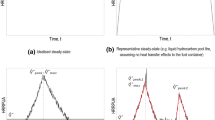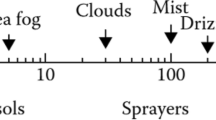Abstract
The cup-burner test method has had a long history as a tool for measuring the minimum flame extinguishing concentrations (MEC) of gaseous fire-extinguishing agents for flammable and combustible liquid fuels. The pioneering work by Hirst and Booth (1977) set out the basic principles of the cup-burner and its use. Saso et al. (1993) reported on scale effects on MEC measurement. Preece et al. (2003) reported on parametric effects on MEC measurement. A number of investigators have provided determined values of MEC for a number of inert gas and fluorocarbon agents. See Dlugogorski et al. (1996); Saito et al. (1996); Moore et al. (1998); Sheinson et al. (1998). Takahashi et al. have reported on several investigations of flame extinguishment in the cup-burner including conducting a detailed computational fluid dynamic modeling including reaction kinetics and mass and heat transfer (2003); physical and chemical aspects of flame extinguishment (May 2005); and evaluation of flame extinguishment in low gravity (January 2005). Application of the cup-burner method has, in some instances, produced inconsistent results. MEC values reported by several investigators for the same inert gas agents have exhibited differences that are significant with respect to the way in which they are used (Senecal 2005). Thermochemical analysis and data obtained in a consistent manner suggested that there is a reasonable basis to expect highly consistent, and even predictable, MEC values for inert gas agents. It appeared that the likely source of measurement variation was due to procedural and mechanical differences in the conduct of the cup-burner test among various laboratories. A Task Group, appointed by the NFPA GFE-AAA technical committee on gaseous fire-extinguishing systems, revised the cup-burner test procedure including the specification of a standardized test apparatus. This article describes an inter-laboratory study conducted in 2006 to (1) determine consensus value benchmark minimum extinguishing concentrations (MEC) of an inert gas agent and a halocarbon agent; (2) evaluate the reproducibility of the revised test method; and (3) evaluate the day-to-day consistency (repeatability) of the test method. The results of an inter-laboratory (round robin) study have established benchmark MEC values for nitrogen and HFC-227ea with excellent reproducibility. The results show that MEC values reported by most laboratories were in very good agreement, i.e., exhibited good reproducibility based on averages of three replicate determinations on different days. Analysis of the replicate data revealed a variable degree of repeatability, suggesting that a laboratory will need to review key procedural details in some cases.








Similar content being viewed by others
Notes
See http://www.epa.gov/ozone/ods.html for a list of Class I ozone-depleting substances.
See Underwriters Laboratory standards UL-2127 and UL-2166 as well as ISO standard ISO 14520.
The standard Class A fuel test articles include a wood crib and arrays of polymer sheets employing using three different types of plastics (polypropylene, PMMA—polymethylmethacrylate, and ABS—crylonitrile butadiene styrene polymer), each article constructed and tested according to established specifications.
The large-scale Class B fuel fire test consists of extinguishing a pan fire of the burning fuel. Pan sizes vary slightly among standards but are approximately 0.25 m 2 in area. Heptane is the most commonly used Class B reference fuel.
The Report on Comments (ROC) stage is the final approval step by an NFPA technical committee.
All MEC values were reported to the second decimal place, a level of precision that is retained herein for calculation purposes.
Abbreviations
- i :
-
Index, daily average MEC determination, i = 1 to n
- j :
-
Index, test laboratory, j = 1 to p
- k :
-
Index, individual MEC test in a day, k = 1 to m
- m :
-
Number of individual tests per daily determination of MEC. m = 5. all cases
- n :
-
Number of replicate determinations. n = 3, all cases
- p :
-
Number of laboratories. Nitrogen: p = 8; HFC-227ea: p = 5
- d j :
-
Cell j deviation =\(\bar{x}_j-\bar{X}\)
- h j :
-
Consistency statistic between laboratories =\(d_{\rm j}/s_{\bar{x}}\)
- k :
-
Consistency statistic within a laboratory = s j/s r
- s j :
-
Cell standard deviation laboratory \(j=\sqrt{\sum\limits_{i=1}^n{(x_i-\bar{x}_j)/(n-1)}}\)
- \(s_{\bar{x}}\) :
-
Standard deviation of cell averages =\(\sqrt{\sum\limits_{j=1}^p {d_j^2/(p-1)}}\)
- s r :
-
Repeatability standard deviation =\(\sqrt{\sum\limits_{j=1}^p {s_j^2/p}}\)
- s R :
-
Reproducibility standard deviation =\(\sqrt{s_{\bar{x}}^2+s_r(n-1)/n}\)
- x j,i :
-
MEC test result for laboratory j on day \(i=\sum\limits_{k=1}^m{x_{j,i,k}/m}\)
- \(\bar{x}_j\) :
-
Cell average for laboratory \(j=\sum\limits_{i=1}^n {x_i /n}\)
- \(\bar{X}\) :
-
Average of the cell (laboratory) averages \(=\sum\limits_{j=1}^p{\bar{x}_j/p}\)
- y j,i,k :
-
MEC result k on day i for laboratory j; k = 1 to m
References
ASTM E691, Standard Practice for Conducting an Interlaboratory Study to Determine the Precision of a Test Method, ASTM International, 100 Barr Harbor Drive, PO Box C700, West Conshohocken, PA 19428–2959.
Dlugogorski BZ, Kennedy EM, Morris KA (1996) Thermal behaviors of cup burners. Interflam 96:445–457
Hirst R, Booth K (1977) Measurement of flame-extinguishing concentrations. Fire Technol 5:296–315
ISO 14520-Part 1 (2006) Gaseous fire-extinguishing systems—physical properties and system design, 2nd ed. International organization for standardization
Moore TA, Weitz CA, Tapscott RE (1998) An update on NMERI cup-burner test results. In: Halon options technical working conference, Proceedings, pp 551–564
NFPA 2001 (2004) Standard for Clean Agent Fire Extinguishing Systems. Quincy, National Fire Protection Association
Preece S, Mackay P, Chattaway A (2003) The cup burner method—a parametric analysis of the factors influencing the reported extinguishing concentrations of inert Gases. In: Halon options technical working conference. Albuquerque
Saito Naoshi, Ogawa Yoshio, Saso Yuko, Liao Chihong, Sakei Ryuta (1996) Flame-extinguishing concentrations and Peak Concentrations of N2, Ar, CO2 and Their Mixtures for Hydrocarbon Fuels. Fire Safety Journal 27:185–200
Saso Yuko, Saito Naoshi, Iwata Yusaku (1993) Scale effects of the cup burner on flame extinguishing concentrations. Fire Technology 29(1):22–33
Senecal JA (2005) Flame extinguishing in the cup-burner by inert gases. Fire Safety Journal 40(6):579–591
Senecal JA (2006) Revised NFPA cup-burner test method: improving reproducibility. In: Halon options technical working conference, Albuquerque, pp 4–16
Sheinson RS, Penner-Hahn JE, Indritz Doren (1998) The Physical and Chemical Action of Fire Suppressants. Fire Safety Journal 15:437–450
Takahashi F, Linteris GT, Katta VR (2003) Suppression of cup-burner flames. In: Fourth international symposium on scale modeling (ISSM-IV). Cleveland, pp 17–19
Takahashi F, Linteris GT, Katta VR (2005) Extinguishment of cup-burner flames in low gravity. In: 43rd AIAA aerospace sciences meeting and exhibit AIAA-2005-0711 Reno, NV, pp 10–13
Takahashi, F, Linteris GT, Katta VR (2005) Physical and chemical aspects of cup-burner flame extinguishment. In: Proceedings of the 13th annual Halon Options Technical Working Conference (HOTWC). Albuquerque, pp 24–26
UL-2127 (2001) Inert gas clean agent extinguishing system units. Underwriters Laboratories Inc. (UL), 333 Pfingsten Road, Northbrook, IL 60062–2096
UL-2166 (2001) Halocarbon clean agent extinguishing system units. Underwriters Laboratories Inc. (UL), 333 Pfingsten Road, Northbrook, IL 60062–2096
Author information
Authors and Affiliations
Corresponding author
Annex A
Annex A
Rights and permissions
About this article
Cite this article
Senecal, J. Standardizing the Measurement of Minimum Extinguishing Concentrations of Gaseous Agents. Fire Technol 44, 207–220 (2008). https://doi.org/10.1007/s10694-008-0042-z
Received:
Accepted:
Published:
Issue Date:
DOI: https://doi.org/10.1007/s10694-008-0042-z




